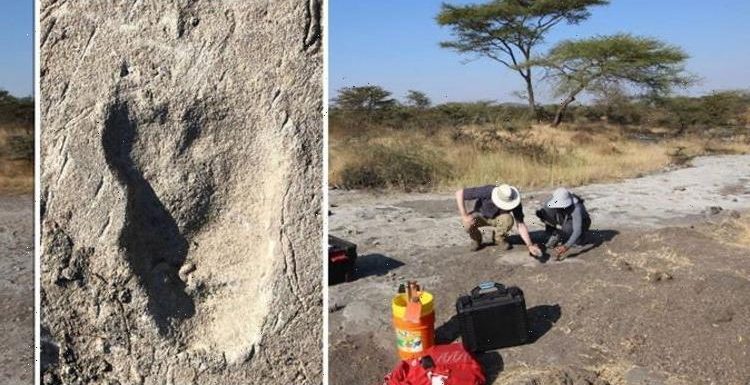
Neanderthals: Expert discusses why species went extinct
We use your sign-up to provide content in ways you’ve consented to and to improve our understanding of you. This may include adverts from us and 3rd parties based on our understanding. You can unsubscribe at any time. More info
Discovered in 1976 by British archaeologist Mary Leakey, the so-called “Lateoli Footprints” have both fascinated and confused researchers. After researchers excavated one set of prints at Lateoli, Tanzania, in 1978, they found “unequivocal evidence of upright walking” in the human lineage dating back 3.7 million years. But when another set of wider prints was discovered at a nearby location, Site A, the footprints were dismissed as those left behind by a bear.
And so, for more than 40 years, the scientists had believed the second set of prints was nowhere near as important as the first – and they were wrong.
Because according to a recent re-excavation of Site A, a team of researchers at Dartmouth University in the US has determined they were made by an early human – an upright walking hominid.
The findings were presented in a new report published in the journal Nature.
Lead author Ellison McNutt said: “Given the increasing evidence for locomotor and species diversity in the hominin fossil record over the past 30 years, these unusual prints deserved another look.”


Professor McNutt, who graduated from Dartmouth and now teaches at the Heritage College of Osteopathic Medicine at Ohio University, was fascinated by the Site A footprints.
Other prints found at Sites G and S have been generally attributed to the Australopithecus afarensis – one of the oldest and best-known progenitors of modern-day humans.
Discoveries in Eastern Africa indicate the species lived between 3.85 and 2.95 million years ago, meaning it has been around more than four times as long as our species, Homo sapiens.
The Site A prints were considerably different to the others found at Lateoli and were long thought to have been made by a young bear walking on its hind legs.
In June 2019, a team of researchers led by study co-author Charles Musiba, an associate professor of anthropology at the University of Colorado Denver, travelled to Tanzania to re-examine the Site A prints.
https://www.youtube.com/embed/yC_bboWFY00
The researchers re-excavated and cleaned a total of five consecutive prints.
They were then measured, photographed and 3D-scanned to better understand their origin.
After comparing the prints to those of black bears, chimpanzees and humans, the conclusions were clear – the prints were made by an early human.
As part of the study, the researchers visited the Kilham Bear Center in New Hampshire, US, where they observed how juvenile black bears walked on their hind legs.


The animals were lured with a bowl of applesauce or maple syrup to walk over a trackway filled with fresh mud to capture their footprints.
After recording more than 50 hours of video, the researchers determined black bears walked on their hind feet less than one percent of the studied time.
Thus, it was unlikely the Site A prints were made by a representative of the ursine kind.
This conclusion was further supported by the fact excavations in Lateoli have not revealed prints left behind by an individual walking on four legs.
Jeremy DeSilva, senior author and an associate professor of anthropology, said: “As bears walk, they take very wide steps, wobbling back and forth.
“They are unable to walk with a gait similar to that of the site A footprints, as their hip musculature and knee shape does not permit that kind of motion and balance.”
He added: “Through this research, we now have conclusive evidence from the site A footprints that there were different hominin species walking bipedally on this landscape but in different ways on different feet.
“We’ve had this evidence since 1976. It just took the rediscovery of these wonderful footprints and a more detailed analysis to get us here.”
Source: Read Full Article